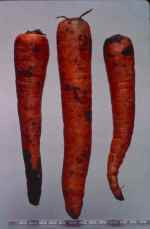Aster Yellows
Mycoplasma (Phytoplasma-like organism PLO)
What to look for?
A common disease in carrot production, it causes losses from trace levels to 10% or more in the unharvested crop. Affected carrots have yellowing leaves and the carrot tap root produces masses of fibrous side roots making it unmarketable. This disease is spread by leaf hoppers that move into the province every year from the central U.S. Aster Yellows affects canola, onions, parsnips and faba beans as well as flowers, forage and field crops.

Photo: Howard | Picture description Yellowed foliage. |
Management strategy
No control strategy.
Black Root Rot
Thielaviopsis basicola (Chalara elegans)
What to look for?
This can be a problem disease on carrots grown on muck or high organic soils. Washed carrots may show black scattered lesions when stored in polythene bags.

Photo: Pepin | Picture description Black rot lesions. |
Management strategy
Root damage and high storage temperatures appear to favour disease development.
Cavity Spot
Pythium spp.
What to look for?
Cavity spot occurs on both parsnips and carrots. Tonnage of the crop is not reduced but the cavities make the roots unmarketable. The disease occurs on carrots grown on mineral or peat (muck) soils.

Photo: Ormrod | Picture description Many cavity spots. |
Management strategy
No control for this disease is known other than growing carrots on new land free of this problem disease.
Common Scab
Streptomyces scabies
What to look for?
This is the same scab that attacks potatoes and other root crops. Alkaline soils and dryish high organic soils are conducive to the development of the superficial disease.

Photo: Evans | Picture description Scab lesions on the carrot surface. |
Management strategy
Avoid potato fields and lower the soil pH if above 7 or more.
Lateral Root Dieback
Pythium spp.
What to look for?
Many pythium species are involved in this disease often referred to as rusty root in Ontario. The disease occurs in both mineral and muck soils.

Photo: Howard | Picture description Fungus causes stubby carrots. |
Management strategy
Avoid land with poor drainage or prone to flooding, improve soil drainage and use precision seeding.
Leaf Blight
Alternaria dauci
What to look for?
The most common leaf disease of carrots and also parsley. This fungus is seed- and residue-borne. Complete loss of foliage can take place during periods of prolonged wet, humid weather.

Photo: McDonald | Picture description Severe leaf spotting by this fungus. |
Management strategy
Seed treatment, crop rotation, and foliar fungicides are used for disease control.
Cercospora Leaf Spot
Cercospora carotae
What to look for?
This disease can be as destructive as Alternaria leaf blight. Again the disease is both seed- and residue-borne. Younger leaves are more susceptible than older leaves.

Photo: McDonald | Picture description Lesions on carrot leaf stems. |
Alternaria dauci

Photo: McDonald | Picture description Carrot leaves totally killed off following infection by the Alternaria leaf blight fungus. |
Management strategy
Fungicidal seed treatment, ploughing under crop residues, crop rotation and foliar fungicides are all control recommendations.
Sclerotinia Rot - White Mold
Sclerotinia sclerotiorum
What to look for?
This is the most destructive disease of carrots in Alberta. The infectious ascospores of this fungus are abundant as a consequence of the build-up of the disease on millions of acres of canola and bean crops. Carrots may show little or no damage incidence in the field but following washing and storage white mold outbreaks often occur on the stored roots. Only a small percentage of the roots may be initially infected but the fungus mycelium can move very rapidly from carrot to carrot. In a matter of weeks the whole storage container may become a mass of white mold and black sclerotia surrounding each and every carrot.

Photo: Howard | Picture description Sclerotinia mold covers carrots. |
Management strategy
Frequent inspection in storage, low temperatures, aeration and washing in a final water of 2-5 % diluted bleach solution may give adequate control. (1 part bleach, (sodium hypochlorite) to 20 parts water.
Bacterial Leaf Blight
Bacterial leaf blight (Xanthomonos campistris pv.carotae) A seed-borne bacterial disease that causes leaf spotting similar to Cercospora or Alternaria blights.
Bacterial Soft Rot
Bacterial soft rot (Erwina carotovora subsp.carotovora) whence the name!, carotovora is from carrot, is a common disease of carrots both in the field and in storage. Grow carrots in well drained soil, grade before storage and rinse in bleach (sodium hypochlorite) as for Sclerotinia control.
Black Rot
Black rot (Alternaria radicina). This disease also attacks the roots and can be a problem on celery, parsnip and dill. The disease can persist for up to 8 years in the soil. Low temperature storage, resistant cultivars and foliar fungicides may reduce disease levels.
Crown Rot and Fusarium Dry Rot
Crown rot (Rhizoctonia solani) and Fusarium dry rot, (Fusarium spp.) may cause problems in stored carrots. Store as cool as possible at 0 oC and avoid planting on land where these diseases previously may have occurred.
Rubbery Brown Rot
Rubbery brown rot (Phytophthora porri) and violet root rot are both sporadic diseases that can occasionally occur on carrots.
Nematodes
Nematodes can attack carrots such as the Northern root-knot nematode (Meloidogyne hapla). This nematode has a very wide-host range and heavy infections may render carrot unmarketable.
Heat Canker
Heat canker in carrots is caused by tissues of the root at or near the soil surface collapsing and dying. from direct summer sunlight, causing major disfigurement of the root. Black or dark soils are most conducive to this type of injury.